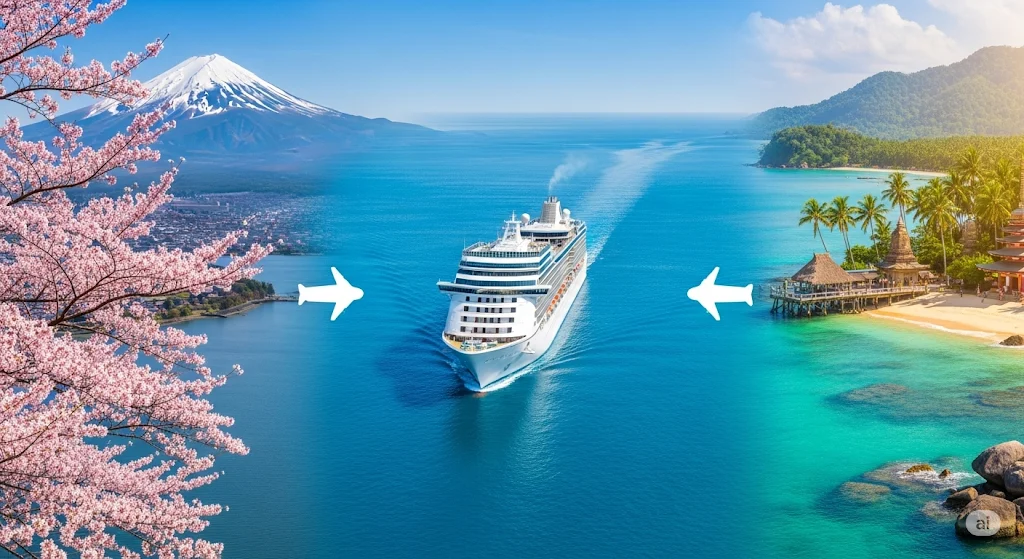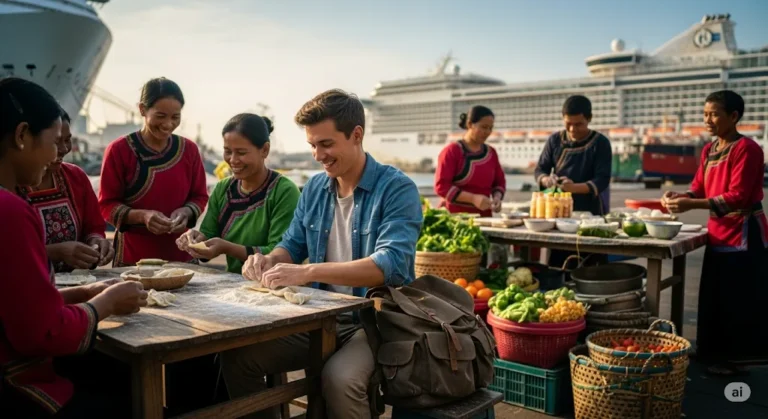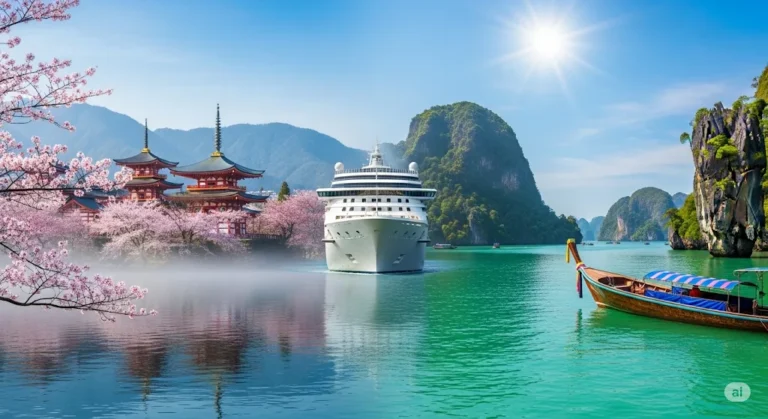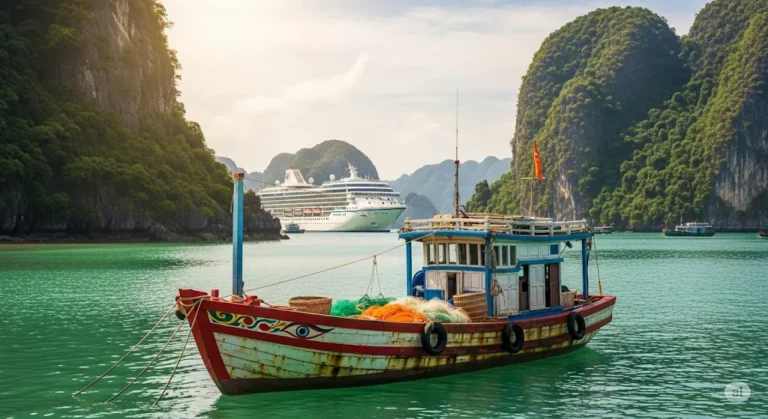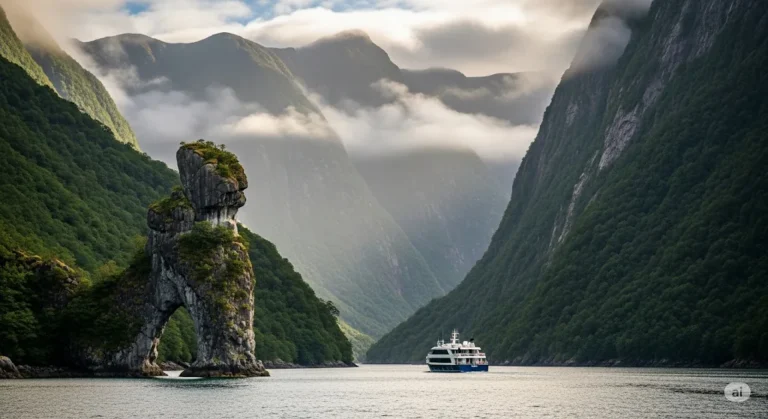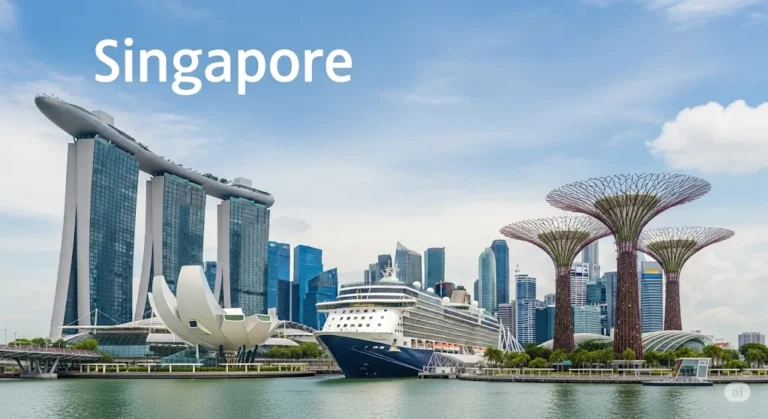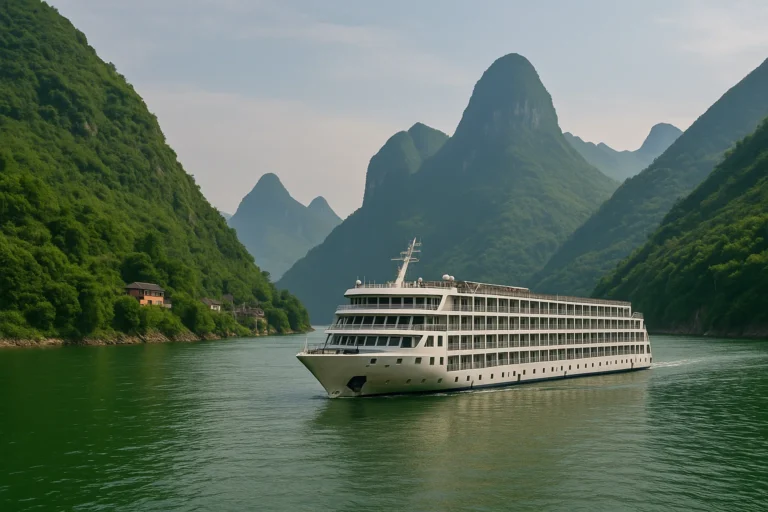Japan vs. Southeast Asia Cruises: Which to Choose?
🌸🏯🏝️ Japan vs. Southeast Asia Cruises: Which to Choose for Your Next Adventure? The Ultimate Deep Dive! The allure of an Asian cruise is undeniable, offering a captivating blend of ancient traditions, vibrant cultures, and breathtaking landscapes. For discerning travelers seeking more than just a vacation, a journey by sea through Asia promises unparalleled insights and unforgettable memories. When planning your dream voyage, two regions frequently emerge as top contenders, each with its distinct charm and unique offerings: Japan, a land where centuries-old traditions coexist seamlessly with dazzling technological advancements, and Southeast Asia, a vibrant tapestry of lush tropical islands, bustling markets, profound spirituality, and diverse ethnic groups. Both destinations promise an enriching cultural immersion and stunning natural beauty, yet they cater to vastly different travel styles, interests, and even budgets.
The decision between a cruise to Japan or Southeast Asia can be a delightful, albeit challenging, dilemma. Do you find yourself drawn to the meticulous order, profound historical narratives, and serene philosophical depths of the Land of the Rising Sun, where every detail is perfected and every interaction steeped in grace? Or perhaps you are more inclined towards the laid-back charm, spontaneous adventures, and kaleidoscopic diversity found in countries like Thailand, Vietnam, Singapore, and Indonesia, where every street corner offers a new sensory delight? This comprehensive guide aims to illuminate the distinct characteristics and unique propositions of each region, delving into their cultural nuances, culinary landscapes, natural wonders, and practical considerations. By exploring what makes each destination truly special, we hope to empower you to navigate your choices with confidence and pick the perfect cruise that aligns with your deepest travel desires. Let’s embark on this detailed exploration and discover which Asian gem awaits your exploration! 🚢✨
🇯🇵 Japan Cruises: A Harmonious Blend of Tradition, Innovation, and Serenity
A cruise to Japan is more than just a vacation; it’s an immersive journey into a culture that reveres its past while boldly embracing the future. It’s a destination that promises unparalleled insights and meticulously crafted experiences at every turn.
🌸 Profound Cultural Depth and Unique Experiences
Japan offers a multifaceted cultural landscape, where ancient traditions are not merely preserved but are living, breathing parts of everyday life. Your cruise will provide unparalleled access to these captivating elements:
- Historical and Spiritual Sanctuaries: Explore the UNESCO World Heritage sites of Kyoto, with its thousands of exquisite temples and serene Zen gardens (e.g., Kinkaku-ji, Fushimi Inari Shrine). Visit Nara, home to Todai-ji Temple and its colossal Buddha statue, surrounded by friendly deer. Experience the solemn reflection at the Peace Memorial Park in Hiroshima, a poignant reminder of resilience and hope. Wander through historic samurai districts in Kanazawa or the picturesque Edo-era streets of Takayama, offering glimpses into feudal Japan.
- Dazzling Modern Metropolises: Discover the pulsating energy of Tokyo, from the iconic Shibuya Crossing to the vibrant anime and electronics hub of Akihabara. Marvel at the architectural wonders of Shinjuku and the imperial grandeur near the Imperial Palace. In Osaka, delve into a city renowned for its lively street food scene and a more down-to-earth atmosphere. Explore Yokohama, a significant port city with a beautiful waterfront and historical Western influences.
- Iconic Seasonal Beauty: Plan your cruise during the breathtaking cherry blossom season (late March to early April), when the entire country is bathed in delicate pink hues – a truly magical spectacle. Alternatively, the vibrant autumn foliage</strong >(October to November) transforms mountains and gardens into a riot of reds, oranges, and golds, offering equally stunning photo opportunities. Winter cruises can reveal snow-capped landscapes, particularly in the north, and unique festivals like the Sapporo Snow Festival.
- Authentic Cultural Immersion: Participate in a meticulously choreographed traditional tea ceremony, learning about its profound spiritual significance. Witness the sheer power and tradition of a sumo wrestling match</strong >(seasonal) or immerse yourself in the theatrical artistry of Kabuki or Noh performances. For ultimate relaxation, indulge in a therapeutic soak at a natural hot spring (onsen), a cherished Japanese tradition. Stroll through meticulously maintained Japanese gardens, designed to evoke serenity and harmony.
🍣 Unparalleled Culinary Excellence
Japanese cuisine is celebrated worldwide for its artistry, fresh ingredients, and intricate flavors. A cruise to Japan is a gastronomic adventure, offering countless opportunities to savor its diverse culinary landscape:
- Refined Delicacies: Indulge in the freshest sushi and sashimi, prepared by masterful chefs. Experience Kaiseki, a multi-course haute cuisine dinner, where each dish is a work of art, reflecting the season and local ingredients. Try delicate tempura, perfectly fried light batters.
- Comfort Food and Street Eats: Warm up with a steaming bowl of ramen or hearty udon noodles. Explore the vibrant street food scenes in cities like Osaka, famous for its takoyaki (octopus balls) and okonomiyaki</strong >(savory pancakes). Visit bustling food markets like Tsukiji Outer Market (or the new Toyosu Market) in Tokyo, where you can sample incredibly fresh seafood and local snacks.
- Beverage Exploration: Discover the nuanced world of sake (Japanese rice wine) through tastings. Enjoy high-quality Japanese whisky, which has gained international acclaim, or sample a variety of green teas.
✨ Impeccable Service and Seamless Efficiency
Japan is globally recognized for its exemplary standards of service, known as omotenashi (wholehearted hospitality), and remarkable efficiency, ensuring a remarkably smooth and stress-free travel experience:
- Punctuality and Precision: Whether it’s the legendary Shinkansen (bullet train) or your scheduled shore excursion, expect unparalleled punctuality. This reliability minimizes travel stress and maximizes your exploration time.
- Spotless Environment: Cities and public spaces, even in the busiest areas, are meticulously clean and well-maintained, contributing to a pleasant and hygienic travel environment.
- Unwavering Safety: Japan consistently ranks among the safest countries in the world, offering travelers immense peace of mind. Street crime is exceptionally low, allowing for comfortable independent exploration.
- Exceptional Hospitality: From hotel staff to shopkeepers, you’ll encounter a high degree of politeness, attentiveness, and a genuine desire to assist, even if language barriers exist.
🚢 Practicalities of Cruising Japan
Navigating Japan as a foreign traveler, especially via cruise, offers unique advantages:
- Language and Communication: While English proficiency can vary, especially outside major tourist hubs, most cruise lines operating in Japan provide English-speaking guides for shore excursions. Translation apps are highly effective, and Japanese people are often incredibly helpful.
- Connectivity: Wi-Fi is widely available in hotels, many public spaces, and on most cruise ships. Portable Wi-Fi devices or eSIMs are also popular for consistent internet access.
- Currency and Payments: The Japanese Yen (JPY) is the official currency. While credit cards are accepted in many larger establishments, cash is still widely used, especially in smaller shops, restaurants, and for public transport. ATMS at convenience stores (like 7-Eleven) are foreigner-friendly.
- Local Customs and Etiquette: Understanding basic Japanese etiquette (e.g., bowing, removing shoes indoors, no tipping) enhances your experience and shows respect for the local culture. Your cruise line will often provide guidance.
💎 Beyond the Mainstream: Lesser-Known Gems and Unique Routes
While major cities are popular, some Japan cruises delve into less-explored, equally captivating regions:
- Hokkaido: Explore the northernmost prefecture, known for its pristine nature, national parks, and delicious dairy products. Ideal for summer cruises.
- Kyushu: Discover the island’s volcanic landscapes, hot springs, and vibrant history, including Nagasaki’s significant role in global history.
- Shikoku: The smallest of Japan’s four main islands, offering spiritual pilgrimages, dramatic coastal scenery, and traditional art.
- The Seto Inland Sea: Cruise through this beautiful sea dotted with islands, many hosting contemporary art installations (e.g., Naoshima Art Island).
🛳️ What to Expect Onboard Japan Cruises
Major international cruise lines (e.g., Princess Cruises, Holland America Line, Celebrity Cruises, Royal Caribbean) offer itineraries in Japan. Some Japanese lines like NYK Cruises also cater to international guests. Expect:
- Tailored Experiences: Many cruises will offer Japanese-themed nights, traditional performances, and workshops (e.g., origami, calligraphy).
- Language Support: Multi-lingual staff and announcements, often with specific Japanese cultural liaisons.
- Shore Excursions: Carefully curated excursions designed to provide deep cultural insights, often including local transport to key sites.
🌴 Southeast Asia Cruises: A Tropical Tapestry of Adventure and Enchantment
Southeast Asia is a captivating region characterized by its breathtaking natural beauty, ancient spiritual sites, and a dynamic fusion of cultures. A cruise here is an adventure for the senses, offering vibrant colors, tantalizing aromas, and warm hospitality at every stop.
🏖️ Diverse Landscapes and Pristine Natural Beauty
The natural wonders of Southeast Asia are as diverse as they are stunning, from idyllic coastlines to dense jungles:
- World-Renowned Beaches and Islands: Unwind on the powdery white sands of Phuket and Koh Samui in Thailand, or discover the dramatic limestone karsts rising from the emerald waters of Halong Bay in Vietnam. Experience the pristine, crystal-clear waters and vibrant marine life around Palawan (Philippines) and the stunning islands of Indonesia like Bali and Komodo. Activities often include snorkeling, diving, kayaking, and sunbathing.
- Lush Rainforests and Wildlife: Trek through ancient rainforests in Borneo (Malaysia/Indonesia) to spot orangutans in their natural habitat, or explore the rich biodiversity of Sumatra (Indonesia). Many cruises offer excursions into national parks for wildlife spotting, birdwatching, and waterfall visits.
- Dramatic Volcanic Landscapes: In Indonesia, witness the awe-inspiring beauty of active volcanoes like Mount Bromo or Mount Rinjani, offering challenging treks and panoramic sunrises.
- Rivers and Deltas: Experience the lifeblood of countries like Vietnam with a boat trip through the bustling Mekong Delta, observing local life and floating markets.
🕌 Rich and Vibrant Cultural Tapestry
Southeast Asia is a melting pot of cultures, religions, and traditions, offering a fascinating journey through diverse heritage:
📂 Explore More in These Categories
- Ancient Wonders and Spiritual Sites: Marvel at the sheer scale and intricate carvings of Angkor Wat in Cambodia, a vast temple complex that is a testament to the Khmer Empire. Explore the thousands of ancient temples of Bagan in Myanmar, or admire the glittering golden temples and grand palaces of Bangkok, Thailand. Witness the serene ritual of Buddhist monks collecting alms in Luang Prabang</strong >(Laos) or delve into the unique Hindu culture and artistry of Bali</strong >(Indonesia).
- Bustling Markets and Urban Energy: Immerse yourself in the vibrant chaos and sensory delights of local markets. Experience the unique charm of the floating markets in Thailand or the bustling night markets of Vietnam, offering everything from street food to local crafts. Explore the modern marvels and diverse neighborhoods of Singapore, a cultural crossroads and culinary paradise, including its famous hawker centers.
- Traditional Arts and Crafts: Witness traditional dance performances (e.g., Apsara in Cambodia), observe intricate silk weaving in Vietnam, or explore artisan workshops creating lacquerware, wood carvings, and batik textiles.
🍜 Vibrant, Aromatic, and Diverse Cuisine
Southeast Asian food is a highlight for many travelers, known for its incredible flavors, fresh ingredients, and aromatic spices. Each country offers a distinct culinary experience:
- Street Food Heaven: Indulge in an endless array of delicious and incredibly affordable street food. Savor the sweet and sour notes of Pad Thai and the spicy kick of Tom Yum Goong in Thailand. Enjoy a refreshing bowl of Pho or a savory Banh Mi sandwich in Vietnam. Explore the rich curries and diverse flavors of Malaysia and Indonesia (e.g., Nasi Goreng, Laksa).
- Exotic Fruits: Discover a kaleidoscope of unique tropical fruits, from the pungent but beloved durian to the sweet mangosteen, rambutan, and dragon fruit.
- Hands-on Culinary Experiences: Many cruise excursions offer cooking classes, where you can learn to prepare iconic local dishes from scratch, allowing you to bring the authentic flavors of Southeast Asia home with you.
💰 Affordability and Exceptional Value
One of the significant advantages of cruising Southeast Asia is the generally more budget-friendly travel experience compared to Japan, offering exceptional value for money:
- Lower Local Costs: Excursions booked independently, local transportation (e.g., tuk-tuks, taxis, Grab/Go-Jek ride-sharing apps), dining in local restaurants, and shopping for souvenirs are typically much more affordable than in Japan.
- Spa and Wellness: Enjoy rejuvenating massages and spa treatments at a fraction of the cost found in Western countries or Japan.
- Rich Experiences, Lower Price Tag: This affordability allows travelers to participate in more activities, try a wider variety of local cuisine, and purchase more souvenirs without significantly impacting their overall budget.
🌊 The Bustle and the Charm: Navigating Southeast Asia
Southeast Asian cities can be a vibrant, sometimes chaotic, symphony of sights, sounds, and smells. Embracing this energy is key to enjoying the region:
- Embrace the Energy: Cities like Bangkok, Ho Chi Minh City, and Jakarta are alive with constant movement. Embrace the organized chaos of traffic, the lively street vendors, and the bustling markets.
- Local Transportation: Experience unique local transport like tuk-tuks in Thailand, cyclopousses in Vietnam, or rely on ubiquitous and affordable ride-sharing apps like Grab (Southeast Asia’s Uber equivalent) or Go-Jek (Indonesia).
- Warmth of the People: Southeast Asians are renowned for their warm hospitality, genuine smiles, and friendly nature, making interactions with locals a memorable part of your trip.
💊 Health and Safety Considerations
While generally safe for tourists, it’s wise to be mindful of certain health and safety aspects:
- Food and Water Safety: Stick to bottled water. Be cautious with street food, especially raw items or those not cooked thoroughly. Choose vendors with high turnover.
- Mosquito Protection: Use insect repellent, especially in rural areas or during dawn/dusk, to prevent mosquito-borne diseases.
- Sun Protection: The tropical sun is intense. Use high SPF sunscreen, wear hats, and seek shade during peak hours.
- Minor Scams: Be aware of common tourist scams (e.g., inflated taxi fares, fake gems) and research common pitfalls for each specific country.
🎯 Tailoring Your Southeast Asia Experience
Each country in Southeast Asia offers a distinct flavor, allowing you to tailor your cruise to specific interests:
- Thailand: Known for stunning beaches, vibrant nightlife, delicious food, and ancient temples.
- Vietnam: Offers rich history, beautiful landscapes (Halong Bay, Mekong Delta), and a unique culinary heritage.
- Singapore: A modern, efficient city-state with fantastic food, shopping, and green spaces, serving as a popular embarkation/disembarkation point.
- Malaysia: A blend of Malay, Chinese, and Indian cultures, with bustling cities (Kuala Lumpur) and beautiful islands.
- Indonesia: Home to Bali’s spiritual ambiance, Java’s ancient temples (Borobudur), and dramatic volcanic landscapes.
- Cambodia: Primarily visited for the magnificent Angkor Wat complex, a profound historical experience.
🛳️ Cruise Lines and Itineraries in Southeast Asia
Numerous international cruise lines operate in Southeast Asia, offering diverse itineraries. Some popular choices include Royal Caribbean, Princess Cruises, Celebrity Cruises, Holland America Line, and for luxury options, Azamara or Silversea. Itineraries often connect:
- Major Hubs: Singapore, Hong Kong (though geographically North Asia, often included), and sometimes a gateway to/from Australia or Japan.
- Coastal Cities: Calls in Vietnam (Ho Chi Minh City, Hue/Da Nang, Halong Bay), Thailand (Bangkok, Phuket), and Malaysia (Kuala Lumpur, Penang).
- Island Hopping: Some itineraries focus more on the islands of Indonesia or the Philippines.
🤔 Making Your Choice: Key Considerations for the Discerning Cruiser
To help you navigate this wonderful dilemma, let’s delve deeper into the critical factors that will shape your decision and ensure your cruise aligns perfectly with your expectations.
💸 Budget and Value for Money
- Japan: The Premium Experience: Generally, a cruise to Japan, including flights, excursions, and onshore spending, tends to be more expensive.
- Higher Base Costs: Cruise fares themselves might be slightly higher due to operational costs and port fees.
- Onshore Spending: Meals outside the ship, transportation, souvenirs, and many independent excursions are typically pricier. For example, a quality meal in Tokyo can easily cost twice or thrice what you’d pay in Bangkok.
- Hidden Costs: Factor in potential visa fees, travel insurance, specialty dining onboard, and desired shore excursions, which can add up.
- Southeast Asia: Exceptional Value: Southeast Asia generally offers a more budget-friendly adventure, making it an excellent choice for those seeking more experiences for their money.
- Affordable Excursions: Independent tours, local transport (e.g., tuk-tuks), and street food are incredibly cheap, allowing for extensive exploration without breaking the bank.
- Spa & Wellness: Indulge in massages and spa treatments at significantly lower costs than in Japan or Western countries.
- Shopping: Markets offer fantastic deals on clothing, handicrafts, and electronics, especially if you enjoy haggling.
✈️ Travel Style and Personal Preferences
- Choose Japan if you:
- Appreciate order, efficiency, and cleanliness above all else.
- Seek deep cultural immersion through structured experiences like tea ceremonies, temple visits, and art forms.
- Are fascinated by the blend of ancient traditions and cutting-edge technology.
- Prefer a generally calmer, more serene environment for exploration.
- Enjoy exquisite culinary precision and a refined dining experience.
- Opt for Southeast Asia if you:
- Crave adventure, spontaneity, and diverse natural beauty, from beaches to jungles.
- Enjoy a more sensory-rich, bustling, and sometimes chaotic atmosphere (especially in cities).
- Are interested in a wide range of vibrant cultures and spiritual practices within a single region.
- Seek exceptional value</strong >for your travel budget, allowing for more experiences.
- Love bold, aromatic, and diverse street food</strong >and active market explorations.
☀️ Time of Year and Weather Patterns
- Japan: Seasonal Highlights and Considerations:
- Spring (Late March – Early April): Peak season for cherry blossoms; mild and pleasant. Book well in advance!
- Autumn (October – November): Beautiful fall foliage; crisp, comfortable weather. Another highly popular time.
- Summer (June – August): Can be hot and very humid, with occasional typhoons, especially in late summer. Less crowded, but intense heat.
- Winter (December – February): Cold, especially in northern regions, but offers unique experiences like snow festivals and fewer crowds.
- Southeast Asia: Tropical Climate and Monsoon Seasons:
- Dry Season (November – April): Generally the most ideal time for cruising across most of the region, with sunny skies and lower humidity.
- Wet/Monsoon Season (May – October): Characterized by higher humidity and daily, often short, heavy downpours. While rain can occur, it rarely ruins an entire day, and lush landscapes are at their greenest. Specific monsoon patterns vary by country (e.g., Vietnam has different monsoon seasons in the North vs. South).
- Year-Round Warmth: Temperatures remain warm to hot throughout the year, so pack light clothing regardless of season.
🗺️ Ports of Call and Itinerary Focus
- Japan Cruise Ports:
- Tokyo (Yokohama/Tokyo Bay): Gateway to the bustling capital, offering everything from imperial gardens to futuristic districts.
- Osaka (Kobe): Access to Osaka’s vibrant food scene, Universal Studios Japan, and nearby cultural treasures of Kyoto and Nara.
- Hiroshima: A poignant historical city with the Peace Memorial Park and access to the iconic Miyajima Island (Itsukushima Shrine).
- Fukuoka: Known for its unique local cuisine (Hakata ramen) and a gateway to Kyushu’s natural beauty.
- Okinawa: A southern island chain with a distinct Ryukyuan culture, subtropical beaches, and unique history.
- Other Notable Ports: Nagasaki (historic port with European influences), Kanazawa (samurai and geisha districts, traditional gardens), Maizuru (another gateway to Kyoto).
- Southeast Asia Cruise Ports:
- Singapore: A major modern hub, known for its gardens, diverse food (hawker centers), and efficient infrastructure. Often a popular embarkation/disembarkation point.
- Bangkok (Laem Chabang/Klong Toey): Access to glittering temples (Wat Arun, Wat Pho), bustling markets, and a vibrant street scene.
- Ho Chi Minh City (Phu My): Gateway to a city rich in Vietnamese history (Cu Chi Tunnels, War Remnants Museum) and vibrant street life.
- Hanoi (Halong Bay): Iconic for its emerald waters and thousands of towering limestone islands.
- Kuala Lumpur (Port Klang): Malaysia’s capital, featuring the Petronas Twin Towers, diverse cuisine, and cultural melting pot.
- Phuket (Thailand): Famous for stunning beaches, island hopping (Phi Phi Islands), and vibrant nightlife.
- Other Notable Ports: Penang (Malaysia, known for street art and food), Bali (Indonesia, spiritual and artistic hub), Boracay (Philippines, world-class beaches).
♿ Accessibility and Mobility
- Japan: Generally highly accessible, especially in major cities. Public transportation is excellent, and many modern attractions are wheelchair-friendly. However, some older temples or traditional sites may have stairs or uneven paths. Cruise lines are well-equipped to assist.
- Southeast Asia: Accessibility can be more challenging, particularly outside major urban centers. Sidewalks can be uneven, and public transport may not always be fully accessible. However, many tour operators and cruise lines are increasingly offering tailored accessible excursions.
🗣️ Language and Communication
- Japan: English proficiency, while improving, can be limited outside major tourist areas and international hotels. However, Japanese people are incredibly polite and eager to help. Translation apps are invaluable.
- Southeast Asia: English is widely spoken in tourist areas and major cities, especially in countries like Singapore and the Philippines. In more rural areas, communication might be more challenging, but basic English is often understood.
🚶 Shore Excursions: Curated vs. Independent Exploration
- Cruise Line Excursions: Offer convenience, guaranteed return to the ship, and expert guides. Often pricier, but hassle-free. This can be particularly beneficial in Japan where language can be a barrier, or for complex logistics in Southeast Asia.
- Independent Exploration:
- Japan: Highly feasible due to excellent public transport. Research is key, and having a portable Wi-Fi device helps immensely. Can save money and offer more flexibility.
- Southeast Asia: Very popular due to affordability of local transport (taxis, Grab, tuk-tuks) and independent guides. Offers a more authentic, sometimes chaotic, experience. Be mindful of bargaining and agreeing on prices beforehand.
❓ Frequently Asked Questions (FAQ) about Asian Cruises
1. What is the best time to cruise in Japan?
The most popular and arguably best times are during spring (late March to early April) for cherry blossoms and autumn (October to November) for stunning fall foliage and pleasant temperatures. Summer (June-August) can be very hot and humid with typhoon risks, while winter (December-February) is cold but offers unique cultural experiences and fewer crowds.
2. When is the ideal season for a Southeast Asia cruise?
The dry season, typically from November to April, offers the most favorable weather conditions across most of Southeast Asia, characterized by sunny skies, lower humidity, and less rainfall. While the wet season (May to October) brings more rain, downpours are often short and intense, and landscapes are at their most lush.
3. Are visas required for Japan or Southeast Asian countries?
Visa requirements vary greatly depending on your nationality. Many countries offer visa-free entry for short tourist stays in Japan (e.g., US, UK, EU citizens). For Southeast Asia, requirements differ by country (e.g., Vietnam often requires a visa, while Thailand offers visa-free entry for many nationalities). It is crucial to check the latest visa regulations for each specific country on your itinerary well in advance of your trip with the respective embassy or consulate.
4. What currency should I use in Japan and Southeast Asia?
In Japan, the official currency is the Japanese Yen (JPY). While credit cards are widely accepted in larger establishments, cash is still very prevalent for smaller purchases. In Southeast Asia, each country has its own currency (e.g., Thai Baht (THB), Vietnamese Dong (VND), Singapore Dollar (SGD), Malaysian Ringgit (MYR), Indonesian Rupiah (IDR)). Major credit cards are accepted in many urban areas, but having some local currency, especially smaller denominations, is essential for street vendors, local markets, and smaller shops.
5. What should I pack for an Asian cruise?
Pack light, breathable clothing suitable for warm and humid climates in Southeast Asia, with layers for air-conditioned interiors. For Japan, consider layers, especially during spring and autumn, as temperatures can vary. Comfortable walking shoes are absolutely essential for exploring cities and historical sites. Don’t forget swimwear, high SPF sun protection (hat, sunglasses, sunscreen), insect repellent for Southeast Asia, and any necessary personal medications. A universal travel adapter is also highly recommended.
6. Is Wi-Fi readily available on Asian cruises and ashore?
Wi-Fi is typically available on cruise ships, though often for a fee and sometimes slower than ashore. In Japan, public Wi-Fi is widespread, and pocket Wi-Fi devices or eSIMs are popular for continuous connectivity. In Southeast Asia, Wi-Fi is common in hotels, cafes, and restaurants in urban areas. Local SIM cards are very affordable and offer good connectivity ashore.
7. What are the typical dress codes for excursions and on the ship?
Onboard, dress codes vary by cruise line (resort casual, smart casual, formal nights). For shore excursions in both regions, comfortable, respectful clothing is key. When visiting temples, shrines, or other religious sites in both Japan and Southeast Asia, women should ensure shoulders and knees are covered. Men should also wear long pants or respectful shorts. Carry a lightweight scarf or sarong for impromptu temple visits.
🌟 Conclusion – Your Perfect Asian Cruise Adventure Awaits!
Both Japan and Southeast Asia offer profoundly enriching and unforgettable cruise experiences, each with its distinct allure and unique set of advantages. Your ultimate choice will undoubtedly hinge on your personal travel preferences, budgetary considerations, the specific time of year you wish to travel, and the type of immersive adventure you envision.
If your heart yearns for a meticulously organized journey through a land where ancient traditions gracefully dance with futuristic innovations, where service is impeccable, and culinary artistry reaches new heights, then a cruise to Japan might be your ideal destination. It promises a deeply respectful and aesthetically pleasing exploration of culture and history.
Conversely, if you’re drawn to a vibrant symphony of tropical beauty, diverse and bustling cultures, exhilarating adventures, and the incredible value that allows for extensive exploration, then a Southeast Asia cruise could be the perfect fit. It offers a sensory explosion, from pristine beaches to ancient temples and lively markets, all infused with warm hospitality.
Regardless of which captivating region you ultimately choose, an Asian cruise promises a journey filled with awe-inspiring discoveries, profound cultural insights, and an abundance of unforgettable memories that will last a lifetime. Prepare to embark on an adventure that transcends the ordinary and opens your eyes to the magnificent diversity of Asia. Happy travels, and may your voyage be everything you’ve dreamed of and more! 🌏🚢
🔥 Which Asian cruise destination calls to you more after this deep dive: Japan or Southeast Asia? Or perhaps both for different reasons? Share your dream itinerary in the comments below!


